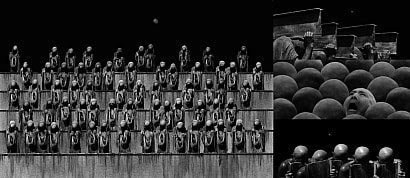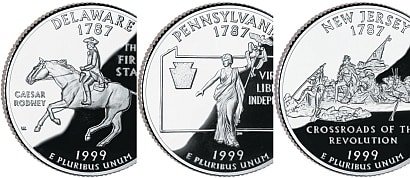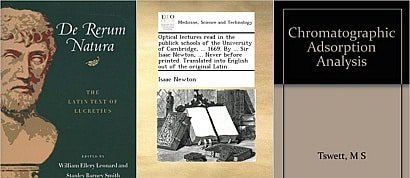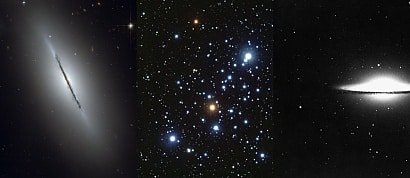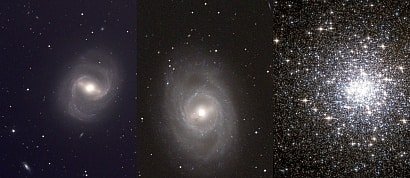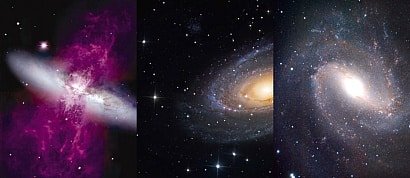 Add image to section
Add image to section
M11
Galactic Cluster in Scutum
Common Names: Wild Duck Cluster
NGC Number: 6705
Visual Magnitude: 6.3
ra: 18h 51.1m
dec: -6° 16'
Located in the constellation Scutum, M11 has been described as one of the richest and most compact open clusters. This cluster lies 6,000 light-years from Earth and has a diameter of about 21 light-years. It is composed of more than 2,900 stars, 600 of which have a visual magnitude brighter than 15. To some, the shape of the cluster resembles that of a flock of flying ducks. This has helped it to earn the name, Wild Duck Cluster. This is an easy target to locate with a pair of binoculars.
Common Names: Wild Duck Cluster
NGC Number: 6705
Visual Magnitude: 6.3
ra: 18h 51.1m
dec: -6° 16'
Located in the constellation Scutum, M11 has been described as one of the richest and most compact open clusters. This cluster lies 6,000 light-years from Earth and has a diameter of about 21 light-years. It is composed of more than 2,900 stars, 600 of which have a visual magnitude brighter than 15. To some, the shape of the cluster resembles that of a flock of flying ducks. This has helped it to earn the name, Wild Duck Cluster. This is an easy target to locate with a pair of binoculars.
 Add image to section
Add image to section
M12
Globular Cluster in Ophiuchus
Common Names: None
NGC Number: 6218
Visual Magnitude: 6.7
ra: 16h 47.2m
dec: -1° 57'
Globular cluster M12, in the constellation Ophiuchus, is nearly a twin of M10. It is just a bit fainter and only slightly larger. Like its twin, it does not contain a lot of variable stars. M12 lies at a distance of 18,000 light-years from Earth and has a diameter of about 75 light-years. Visually it is a fairly remarkable sight. Its visual magnitude of 6.7 makes it an easy target to find with binoculars, and a telescope will bring out its slightly irregular shape.
Common Names: None
NGC Number: 6218
Visual Magnitude: 6.7
ra: 16h 47.2m
dec: -1° 57'
Globular cluster M12, in the constellation Ophiuchus, is nearly a twin of M10. It is just a bit fainter and only slightly larger. Like its twin, it does not contain a lot of variable stars. M12 lies at a distance of 18,000 light-years from Earth and has a diameter of about 75 light-years. Visually it is a fairly remarkable sight. Its visual magnitude of 6.7 makes it an easy target to find with binoculars, and a telescope will bring out its slightly irregular shape.
 Add image to section
Add image to section
M13
Globular Cluster in Hercules
Common Names: Hercules Cluster
NGC Number: 6205
Visual Magnitude: 5.8
ra: 16h 41.7m
dec: +36° 28'
Also known as the Hercules cluster, M13 is perhaps the finest and most well known globular cluster in the Northern hemisphere. It originally was discovered by Edmond Halley in 1714. Halley noted that the cluster could easily be seen with the naked eye on dark, moonless nights. As its common name would imply, M13 lies in the constellation Hercules. It is about 25,000 light-years from us, and has an impressive diameter of about 150 light-years.
Common Names: Hercules Cluster
NGC Number: 6205
Visual Magnitude: 5.8
ra: 16h 41.7m
dec: +36° 28'
Also known as the Hercules cluster, M13 is perhaps the finest and most well known globular cluster in the Northern hemisphere. It originally was discovered by Edmond Halley in 1714. Halley noted that the cluster could easily be seen with the naked eye on dark, moonless nights. As its common name would imply, M13 lies in the constellation Hercules. It is about 25,000 light-years from us, and has an impressive diameter of about 150 light-years.
 Add image to section
Add image to section
M14
Globular Cluster in Ophiuchus
Common Names: None
NGC Number: 6402
Visual Magnitude: 7.6
ra: 17h 37.6m
dec: -3° 15'
Located in the constellation Ophiuchus, globular cluster M14 has a slightly elliptical shape to it. This cluster is noticeably smaller than M10 and M12, but it contains a large number of variable stars, over 70 in all. This cluster has a diameter of about 55 light-years and lies about 23,000 light-years from Earth. It was the sight of a nova in 1938. With a magnitude of 7.6, it can be located with binoculars, although a telescope is required to show any detail in the cluster.
Common Names: None
NGC Number: 6402
Visual Magnitude: 7.6
ra: 17h 37.6m
dec: -3° 15'
Located in the constellation Ophiuchus, globular cluster M14 has a slightly elliptical shape to it. This cluster is noticeably smaller than M10 and M12, but it contains a large number of variable stars, over 70 in all. This cluster has a diameter of about 55 light-years and lies about 23,000 light-years from Earth. It was the sight of a nova in 1938. With a magnitude of 7.6, it can be located with binoculars, although a telescope is required to show any detail in the cluster.
 Add image to section
Add image to section
M15
Globular Cluster in Pegasus
Common Names: None
NGC Number: 7078
Visual Magnitude: 6.2
ra: 21h 30m
dec: -12° 10'
M15 is a globular cluster of stars in the constellation Pegasus. It is perhaps the densest of all the globular clusters in the Milky Way. It is also the only known globular cluster to contain a planetary nebula. M15 contains over 100 variable stars, which ranks it third for variables. It also contains 9 known pulsars. This cluster is 40,000 light-years distant, and with a visual magnitude of 6.2, is a beautiful sight in binoculars and telescopes alike.
Common Names: None
NGC Number: 7078
Visual Magnitude: 6.2
ra: 21h 30m
dec: -12° 10'
M15 is a globular cluster of stars in the constellation Pegasus. It is perhaps the densest of all the globular clusters in the Milky Way. It is also the only known globular cluster to contain a planetary nebula. M15 contains over 100 variable stars, which ranks it third for variables. It also contains 9 known pulsars. This cluster is 40,000 light-years distant, and with a visual magnitude of 6.2, is a beautiful sight in binoculars and telescopes alike.
 Add image to section
Add image to section
M16
Cluster & Nebula in Serpens
Common Names: Eagle Nebula, Star Queen Nebula
NGC Number: 6611
Visual Magnitude: 6.4
ra: 18h 18.8m
dec: -13° 47'
M16 is an open star cluster and cloud of hot gas about 7,000 light-years away in the constellation Serpens. It contains a diffuse nebula and several dark dust lanes known as the Eagle Nebula. The name comes from the shape of the nebula, which resembles a flying eagle. The stars in the cluster formed from the gasses in this nebula, and new stars are still in the process of forming. This bright object can easily be seen with any optical instrument. Color photographs will show off the bright red color of the nebula.
Common Names: Eagle Nebula, Star Queen Nebula
NGC Number: 6611
Visual Magnitude: 6.4
ra: 18h 18.8m
dec: -13° 47'
M16 is an open star cluster and cloud of hot gas about 7,000 light-years away in the constellation Serpens. It contains a diffuse nebula and several dark dust lanes known as the Eagle Nebula. The name comes from the shape of the nebula, which resembles a flying eagle. The stars in the cluster formed from the gasses in this nebula, and new stars are still in the process of forming. This bright object can easily be seen with any optical instrument. Color photographs will show off the bright red color of the nebula.
 Add image to section
Add image to section
M17
Nebula & Cluster in Sagittarius
Common Names: Omega / Horseshoe / Swan / Lobster Nebula
NGC Number: 6618
Visual Magnitude: 7.0
ra: 18h 20.8m
dec: -16° 11'
Located in the constellation Sagittarius, M17 is an open cluster of about 35 stars within a cloud of gas. As with M16, the hot stars cause the nebula to shine brightly. Located about 6,000 light-years from Earth, this is an area of active star formation. A small telescope will reveal the shape that gives this nebula its name, resembling a horseshoe or swan's neck. The glow of the nebula can be seen in a small telescope, while photographs will show the nebula's red and pink colors.
Common Names: Omega / Horseshoe / Swan / Lobster Nebula
NGC Number: 6618
Visual Magnitude: 7.0
ra: 18h 20.8m
dec: -16° 11'
Located in the constellation Sagittarius, M17 is an open cluster of about 35 stars within a cloud of gas. As with M16, the hot stars cause the nebula to shine brightly. Located about 6,000 light-years from Earth, this is an area of active star formation. A small telescope will reveal the shape that gives this nebula its name, resembling a horseshoe or swan's neck. The glow of the nebula can be seen in a small telescope, while photographs will show the nebula's red and pink colors.
 Add image to section
Add image to section
M18
Galactic Cluster in Sagittarius
Common Names: None
NGC Number: 6613
Visual Magnitude: 7.5
ra: 18h 19.9m
dec: -18° 08'
M18 is a small open cluster of about 20 stars located in the constellation Sagittarius. It lies about 5,000 light-years away with a diameter of about 17 light-years. The cluster contains only 12 fairly bright stars, and the cluster is rather loose in appearance. It is not one of the best examples of a galactic cluster, but it is a pretty sight in a small telescope. This a fairly young cluster, containing bright blue as well as yellow and orange stars.
Common Names: None
NGC Number: 6613
Visual Magnitude: 7.5
ra: 18h 19.9m
dec: -18° 08'
M18 is a small open cluster of about 20 stars located in the constellation Sagittarius. It lies about 5,000 light-years away with a diameter of about 17 light-years. The cluster contains only 12 fairly bright stars, and the cluster is rather loose in appearance. It is not one of the best examples of a galactic cluster, but it is a pretty sight in a small telescope. This a fairly young cluster, containing bright blue as well as yellow and orange stars.
 Add image to section
Add image to section
M19
Globular Cluster in Ophiuchus
Common Names: None
NGC Number: 6273
Visual Magnitude: 6.8
ra: 17h 02.6m
dec: -26° 16'
Globular cluster M19 can be found in the constellation Ophiuchus. It is situated about 20,000 light-years from Earth and has a diameter of about 30 light-years. M19 lies very close to the galactic center, only 4,600 light-years from it in fact. This is a relatively bright globular cluster, and is easily identifiable with binoculars. A telescope will reveal the fact that the cluster has an elliptical shape to it.
Common Names: None
NGC Number: 6273
Visual Magnitude: 6.8
ra: 17h 02.6m
dec: -26° 16'
Globular cluster M19 can be found in the constellation Ophiuchus. It is situated about 20,000 light-years from Earth and has a diameter of about 30 light-years. M19 lies very close to the galactic center, only 4,600 light-years from it in fact. This is a relatively bright globular cluster, and is easily identifiable with binoculars. A telescope will reveal the fact that the cluster has an elliptical shape to it.
 Add image to section
Add image to section
M20
Diffuse Nebula in Sagittarius
Common Names: Trifid Nebula
NGC Number: 6514
Visual Magnitude: 9.0
ra: 18h 02.6m
dec: -23° 02'
The Trifid Nebula, M20, is probably best known for its three-lobed appearance. The dark areas are lanes of dark dust that obscure the nebula's light. This diffuse nebula is very large, and is located about 5,000 light-years from Earth. It is illuminated by a hot 7th-magnitude star located deep within. M20 is a magnificent object easily visible with a pair of binoculars. The dark rifts that divide the nebula can be seen in a small telescope. Photographs will show the nebula's bright red, pink, and blue colors.
Common Names: Trifid Nebula
NGC Number: 6514
Visual Magnitude: 9.0
ra: 18h 02.6m
dec: -23° 02'
The Trifid Nebula, M20, is probably best known for its three-lobed appearance. The dark areas are lanes of dark dust that obscure the nebula's light. This diffuse nebula is very large, and is located about 5,000 light-years from Earth. It is illuminated by a hot 7th-magnitude star located deep within. M20 is a magnificent object easily visible with a pair of binoculars. The dark rifts that divide the nebula can be seen in a small telescope. Photographs will show the nebula's bright red, pink, and blue colors.
The Messier objects are a set of over 100 astronomical objects first listed by French astronomer Charles Messier in 1771.
Added to
17 votes
List Of Messier Objects
(11 lists)list by InTheWitheringWind
Published 8 years ago  1 comment
1 comment
 1 comment
1 commentPeople who voted for this also voted for
Film Diary of 2023
My Favorite Characters in Film
Favorite Movies
PHOTOS | Hein Gorny
ART | Misha Gordin
Kaneto Shindo's Films Ranked (1912-2012)
The Fashion Industry in Films
Books read in 2024
Western Movie Posters: Jack Hoxie
Books Scenes | Friedrich Nietzsche
All-Time Favorite 80's Films
U.S. Coins: State Proof Quarters
Vintage Magazine Ads (1930's)
Pin-up Magazines: Paris Life
Joseph Koo's Greatest Hits
More lists from InTheWitheringWind
Science Classic
B.B. Movies*
Messier Catalog (101-110)
Messier Catalog (91-100)
Smile Guide (2013-2017)
Don't F@ck With Ukraine
Messier Catalog (81-90)
 Login
Login






































